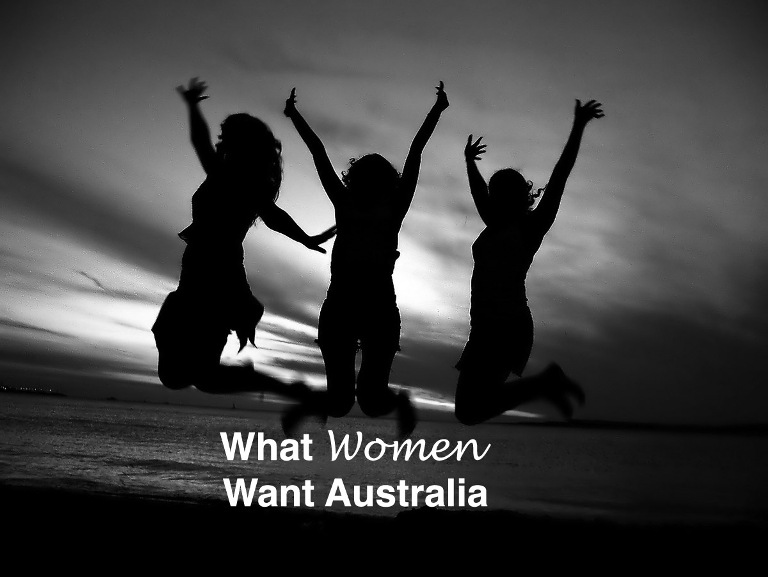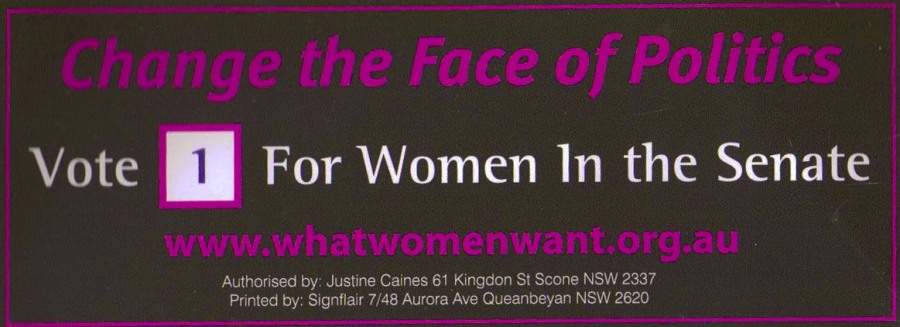How to Start a Women's Party
Featured Community Voice: What Women Want (Australia)
Justine Caines is the founder and leader of the first Australian women's political party, What Women Want (Australia). Created to reform childbirth and maternity healthcare, the party fielded 18 candidates in the 2007 elections and garnered 60,000 votes. Although they did not win, the women were satisfied with their results. Today, they are preparing for the upcoming elections by working on projects that promote women's rights. They have already tasted success: After nine years of campaigning, the Australian government agreed last month to consider funding midwives.

I began thinking about starting a political party for Australian women in 2005. Although I had no clue what starting a national party from scratch entailed, I sensed it would be very difficult. What an understatement!
In Australia, there seems to be only one thing more political than reforming childbirth and that is reforming drug laws. I have worked on both, but have dedicated myself to the former. As the national president of Maternity Coalition Inc., I have been pivotal in pushing for maternity reform, especially the inclusion of midwifes, in the Australian health system.
Since 2000, I have met with virtually every politician at the state and federal level who is concerned about health and women's issues. I have led a media campaign to inform the public and help sway decision makers. Overall, I found that as women and mothers, we were still very much controlled by men--this time, medical men.
Why a Women's Party?
Working on maternity rights for almost a decade, I understood that our work was extremely political. Unfortunately, the country was governed by John Howard, a conservative with little interest in our cause. Our state governments were all Labor but they had little interest in reform without the federal government's involvement.
As a result, women remained captive to a maternity health system based on serving the needs of practitioners and large organizations rather than women and their families.
I began thinking that our campaign had not been very successful and I started to believe that only by entering the political arena would we be able to exert the required pressure.
At the same time I knew a "maternity services party" would get us nowhere. While I wanted to run a major campaign around childbirth reform, I knew that a single-issue party in a multi-issue country was bound to achieve little.
Although social policies affect men and women, I was still committed to forming a party aimed at increasing women's participation. Only 30 percent of Australia's politicians are women; women also carry much of the social policy responsibility.
Women are by and large the caretakers in society and yet has policy continued to fail us. I was firmly of the belief that if we changed the nature of politics (male dominated, testosterone driven) by including more women--particularly women in parties not controlled by men--there was a chance for lasting policy change.
Steps to Starting a Political Party
I began by writing a policy platform (broad statements) that formed the backbone of the Web site. I registered the name "What Women Want Australia." This took about a month. On 31 March, 2007, I blitzed every e-mail list ad contact I knew with a message outlining why I had formed the party.
In the first 24 hours, we had 100 members; within a week we had 400. The Australian Electoral Commission requires there be 500 members before a political party can be registered.
Interest was high; women from different backgrounds united around a party for women. The registration process was arduous: My amazingly supportive husband and I spent many a night preparing required paperwork.
We launched the party on June 28 and were fortunate enough to start the day on a high-rating breakfast television show. From there, the media interest was huge. I lost count of the number of radio interviews I did.
The party was registered in August. By this time, our membership had grown to over 700. We had 18 candidates, including two senate positions for every state and territory and four candidates for seats in the House of Representatives.
Power of the Media
Media interest continued and was very important to our success. As expected, the journalists were fascinated with the party's name and the fact that, as the party's founder, I had six children aged seven and under!
What was particularly interesting was that many of the female journalists and television producers were supportive of our work. As someone who had spent years pitching stories to journalists, I was familiar with the cut-off when someone wasn't interested.
This time around, I was listening to their stories: how hard it was to make it in a male-dominated journalism industry, how unsupportive media agencies were to women's balancing work and family and so on. This genuine interest and support virtually ensured sympathetic and effective media.
How to Campaign
Because I was a community organizer, I was able to call on the childbirth movement to assist in the campaign. A majority of women did join the party and on election day, a contingent also helped with handing out how-to-vote cards. However, many were unable to take the ultimate political step.
Other women unknown to us before joined in. Single mothers were particularly interested because they were very concerned about proposed draconian welfare reforms. One of our candidates was a single mum who ran a very good grassroots campaign.
The party development was done by Sally-Anne Brown, our party secretary, and myself. Sally-Anne had considerable political experience and was pivotal in establishing the party structure and documents, such as the constitution. She took on the role of campaign manager and guided candidates (most of whom had no official political experience) through the campaign. I was essentially the "face of the party" and took a leading role in generating media.
Election Day
Today's electioneering equals big money. Many were staggered that we did not have this backing. Our name assisted us on election day. I have since heard of women who voted for us on election day but did not know of us before entering the voting booth.
The exposure we created made it possible for us to attract over 60,000 votes without spending a cent on advertising. Our budget was around 16,000 Australian dollars. Half of this went to candidate nomination fees (something we covered). We were given a donation to cover the nomination fees, but otherwise all activities were either funded by membership fees, small personal donations or donations in kind.
Where to from Here?
The challenge is to maintain interest with no election on the horizon. I believe this will be difficult. Media interest is now much harder to attract. We need to forge links with many other community and special interest groups, keep relevant and assist with the party's growth.
I believe we ran a very good campaign and the needs for a women's party will continue in Australia. Despite the deputy prime-minister and deputy opposition leader being women, the parties they represent are still well-honed machines of male dominance.
We will demonstrate this in the next election and move from a party that is new and interesting to one that is necessary and in fact the driving force behind change.
Justine Caines
Founder and Leader
What Women Want (Australia)
You can learn about What Women Want (Australia) on our Web site.


